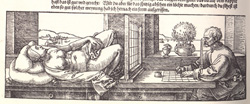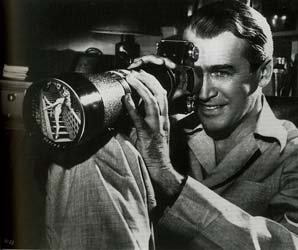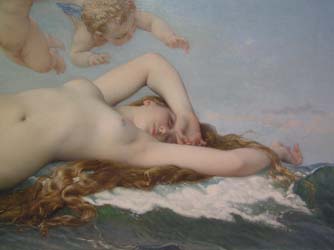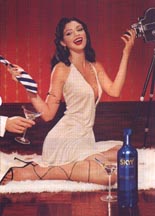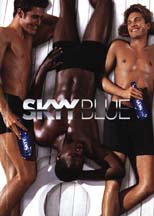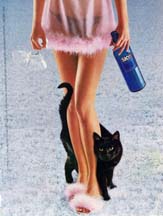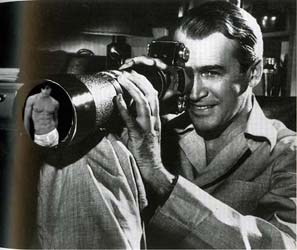Art Home | ARTH Courses |ARTH 200 Assignments
The Changing Concepts of the Gaze
Albrecht Dürer, Artist Drawing a Nude, from The Painter's Manual, 1525. |
Laura Mulvey, "Visual Pleasure and Narrative Cinema," from Visual and Other Pleasures, p. 19: In a world ordered by sexual imbalance, pleasure in looking has been split between active/male and passive/female. The determining male gaze projects its fantasy onto the female figure, which is styled accordingly. In their traditional exhibitionist role women are simultaneously looked at and displayed, with their appearance coded for strong visual and erotic impact so that they can be said to connote to-be-looked-at-ness.
Excerpts from Marita Sturken and Lisa Cartwright, Practices of Looking: An Introduction to Visual Culture, Oxford, 2001.
p. 76: Throughout the history of art, and in the contemporary world of film and advertising, images of women often have been presented in ways that emphasize their status as sexual beings or maternal figures. In 1975 filmmaker and writer Laura Mulvey published a groundbreaking essay about images of women in classical Hollywood cinema. This essay, "Visual Pleasure and Narrative Cinema," used psychoanalysis to propose that the conventions of popular narrative cinema are structured by a patriarchal unconscious, positioning women represented in films as objects of a "male gaze." In other words, Mulvey argued that Hollywood cinema offered images geared toward male viewing pleasure, which she read within certain psychoanalytic paradigms including scopophilia and voyeurism. The concept of the gaze is fundamentally about the relationship of pleasure and images. In psychoanalysis, the term "scopophilia" refers to pleasure in looking, and exhibitionism in the pleasure of being looked at. Both of these terms acknowledge the ways in which reciprocal relationships of looking can be sources of pleasure. Voyeurism is the pleasure in looking while not being seen, and carries a more negative connotation of a powerful, if not sadistic, position. The idea of the camera as a mechanism of voyeurism has been often discussed, since, for instance, the position of viewers of cinema can be seen as voyeuristic --they sit in a darkened room. where they cannot be seen, in order to watch the film. In Mulvey's theory, the camera is used as a tool of voyeurism and sadism, disempowering those before its gaze. She and other theorists who pursued this line of thinking examined certain films of classic Hollywood cinema to demonstrate the power of the male gaze.
/p. 77 Alfred Hitchcock's Rear Window (1954) is a popular example of a film that is explicitly about gendered looking. The film's main protagonist is Jeffries (Jimmy Stewart), a photographer who has broken his leg and is temporarily confined to a wheelchair in his New York City apartment. Jeffries spends much of his time seated at a window that affords him a perfect view into the windows of the various people who live in the building across the way, where he believes he has witnessed evidence of a murder. Rear Window has been read by film theorists (including Mulvey) as a metaphor of the act of film viewing itself, with Jeffries standing in for the cinematic audience/ Confined to a fixed position like the film viewer, his gaze is similarly voyeuristic in that he freely looks but is not /p. 78 seen by the objects of his gaze. Like characters in a movie, his neighbors are apparently unaware that this audience of one exists, much less that he has seen them up close in the intimate setting of their homes. The windows frame their actions just as the camera frames narrative action in a film, both determining and restricting what Jeffries can know about their lives, and generating in him a desire to see and know more. The studio advertising still pictured on the previous page shows us one of the objects of his interest, a dancer, captured in his lens. In the film, we see through his point of view as he observes his neighbors and tracks the movements of his girlfriend Lisa (Grace Kelly) as she becomes his mobile surrogate, his "private eye." Lisa steals up the fire escape across the way to search for murder clues in the off-screen space beond the window frame that is off-limits to Jeffries and us, the film viewers.
Rear Window is a quintessential example of the male gaze in relationship to female objects of visual pleasure. Yet, as the example of Lisa's investigation suggests, the male gaze is not as controlling and powerful as some theorists have suggested. Jeffries gains power by looking, but he is emasculated by his confined state, and must rely on the eyes and legs of a woman to gain access to knowledge. The cinematic viewer, like Jeffries, is confined to a fixed seat and the field of vision offered by this position and the restricted framing of the scene. The gendered relations of power of the cinematic gaze are clearly quite complex. Indeed, not only is Jeffries frustrated in his attempts to know more, he is also punished for looking. Once Jeffries gets caught looking, he becomes vulnerable and trapped; the murderer comes looking for him. Clearly, male looking is not without its limitations and its consequences....
Whereas analysis of the gaze in cinema takes into account the
context of /p. 79 the audience sitting in a darkened theater, and the role
of narrative and motion in viewer identification with the cinematic apparatus,
concepts of the gaze in still images have concentrated more specifically
on the different kinds of looks that an image can imply. In the history of
art, the fact that paintings were geared toward male viewers had as much
to do with the commerce of art as it did with the social roles and sexual
stereotypes of men and women. 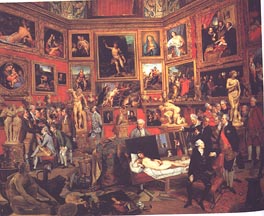 Until
quite recently, most collectors of art were men and the primary viewing audience
of art was men. Since the owner of a painting was understood to be male,
its spectator was also defined as such. In a typical depiction of a female
nude, for instance, a woman is posed so that her body is on display for the
viewer, who is implied to be male by the codes of the image. The female body
is thus understood her in terms of form and allure, as an object before the
viewer's gaze. There is a long tradition in art of defining the female nude
as the project /p.80 and possession of the male artist. In these paintings,
the men gaze upon the female figures as possessions. The women are the objects
of the male gaze, and their returning looks are accorded no power in the
image.
Until
quite recently, most collectors of art were men and the primary viewing audience
of art was men. Since the owner of a painting was understood to be male,
its spectator was also defined as such. In a typical depiction of a female
nude, for instance, a woman is posed so that her body is on display for the
viewer, who is implied to be male by the codes of the image. The female body
is thus understood her in terms of form and allure, as an object before the
viewer's gaze. There is a long tradition in art of defining the female nude
as the project /p.80 and possession of the male artist. In these paintings,
the men gaze upon the female figures as possessions. The women are the objects
of the male gaze, and their returning looks are accorded no power in the
image.
The image convention of depicting women as objects of the gaze
and men /p. 81 as lookers continues to exist today, although in an image
that is considerably more complex. This convention has many cultural and
social implications. In the classic Western tradition of images, which was
dominant throughout the history of painting, men were depicted in action
and women as objects to be looked at. John Berger wrote that in this history
of images, "men act, women appear." Berger noted that the tradition of the
nude in painting was almost exclusively about images of nude women who wre
presented for male viewers. Indeed, the women in these paintings were oftern
turned away from the men depicted within the pictures toward the spectator.
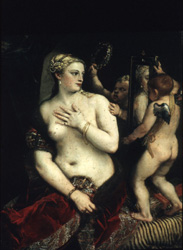 This way of viewing women thus defined them by their appearance, in essence
their ability to be pleasing to look at, and this carries important weight
in the context of contemporary image culture. The implication of a male gaze
was often depicted quite literally in the history of painting with a woman
whose body is turned toward the (presumably male) viewer, but whose head
to turned to gaze into mirror. This image convention has also been used extensively
by advertisers.
This way of viewing women thus defined them by their appearance, in essence
their ability to be pleasing to look at, and this carries important weight
in the context of contemporary image culture. The implication of a male gaze
was often depicted quite literally in the history of painting with a woman
whose body is turned toward the (presumably male) viewer, but whose head
to turned to gaze into mirror. This image convention has also been used extensively
by advertisers.
One of the primary elements of the concept of the gaze is a kind of split that viewers experience in looking at images. This is related to Lacan's notion of the alienation that results from the split between seeing the image as oneself and also as an ideal --as both thesame and not the same as oneself. This can also be understood as the split that results from being simultaneously the surveyor and the surveyed, in looking at oneself through the implied gaze of others. The split self of the viewer is always connected to the idea that the gaze is omnipresent.
p. 82: Today, we are surrounded on a daily basis by images of fashion models whose looks conform to a rigid set of normative codes about beauty. The cultural practices of cosmetics, plastic surgery, dieting, fitness programs, and image management go hand in hand with an image culture that incites women, and increasingly men, to see themselves and their appearance as inadequate in some way and in need of improvement. Berger's dictum "men act and women appear," still applies to /p. 83 images today. However, in Euro-American cultures, the traditional roles of men and women are in upheaval, and women are increasingly socially defined by their work in addition to their appearance. In addition, men are increasingly subject to many of the does of appearance management that were once considered to be exclusively female. While men have been protrayyed through twentieth-century advertising images as men in action, whose rigid muscular frames and active poses counter their role as objects of the gaze, today they are increasingly shown in an array of poses that were previously understood as specifically feminine.
Image conventions have changed, and so have the way of understanding traditional images. The theoretical concept of the male gaze has been rethought, in particular because of the ways in which it could not account for the pleasures of female viewers (except by seeing them as masochistic or as viewing "as men") or for the male figure as the object of the gaze....
p. 87: These changing views of scholarship, and the idea of what kinds of images were important objects of intellectual inquiry, have been paralleled by trends in image-making that reflect new concepts of gender and aesthetic conventions. Contemporary visual culture involves not only a highly complex array of images and spectators but also gazes. There in contemporary images, be they art, news, advertising, television, or film images, a broad array of gazes and implied viewers. Some may be voyeuristic, sadistic, or assaultive, others loving or passionate. Some gazes can be seen as policing, normalizing, or inspecting. Some images...may subject both men and women to the gaze. Yet, it is also possible to see images that deflect a possessive gaze and gazes that are respectful and non-objectifying. It is thus central to the ways that the concept of the gaze has been rethought that we can think of many different kinds of gazes, each with a different relationship to power, and that these gazes are not seen strictly along the lines of male and female.
The desires that spectators have in looking and being looked at are caught /p. 88 up in relationships of power. Traditionally, this meant that the spectators was always perceived to have more power than the object of the gaze (or person looked at), but the contemporary landscape of images shows that this is not always the case. In contemporary advertising, for instance, the idea of a powerful or disempowering gaze is often the source of a joke or counter gaze. In a much-discussed diet Coke television ad, a group of women office workers meet every day at 11:30 to gaze longingly on a muscled construction worker who takes a morning break by drinking a diet coke. A humorous reversal of the stereotype of male construction workers ogling women on the street, the ad prompted a public discussion about what it means when women look at men with desire.
A potentially objectifying gaze can be deflected in an image,
if the subject refuses to acknowledge it. For instance, in the diet Coke
ad, the power of the women to gaze is thwarted by the man's refusal to acknowledge
their presence. Part of the tradition of imagin men as objects of desire
has involved particular codes of resisting the power of the gaze upon them.
For instance men have been traditionally depicted in action...which negates
attempts to objectify them because they are shown powerfully within the frame.
Hyper-muscled bodies, even if they are stationary, have the effect of connoting
action and hence also work to give more power to the subject. 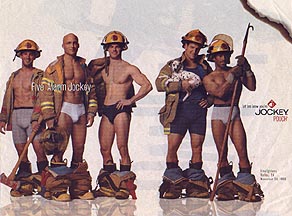 In addition,
men are often shown as either confronting the gaze or turning away from it.
In this ad for Jockey underwear, five male fire fighters retain many of the
image codes of the traditional male figure in their defiant stances and stares
at the camera. These authoritative poses create a comic tension with the
fact that they are standing in their underwear.
In addition,
men are often shown as either confronting the gaze or turning away from it.
In this ad for Jockey underwear, five male fire fighters retain many of the
image codes of the traditional male figure in their defiant stances and stares
at the camera. These authoritative poses create a comic tension with the
fact that they are standing in their underwear.
/p. 90 While many contemporary advertisements
continue to sell products through traditional gender codes, by portraying
women in demure, seductive poses for a possessive male gaze..., other ads
play off these traditions by reversing them and showing both the pleasure
of looking at men as objects and the power of women in action. In this cologne
ad, the male figure is posed in a state that is classically associated with
female figures. He reclines with his body turned toward the camera, and we
can see him as /p. 91 an object of beauty. Is he objectified by the camera's
gaze? What kind of gaze does this image invoke? Can we say that it is a female
gaze, one that defines men as looked upon by women? 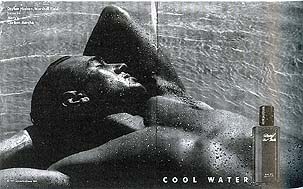 Or
that the male figure continues to retain power before the gaze simply because
of the conventions of the image with which we are familiar? Certainly it
would be argued that this ad is selling an image of the sensitive, new man,
who is confident enough in his masculinity to be the object of a desiring
gaze.
Or
that the male figure continues to retain power before the gaze simply because
of the conventions of the image with which we are familiar? Certainly it
would be argued that this ad is selling an image of the sensitive, new man,
who is confident enough in his masculinity to be the object of a desiring
gaze.
